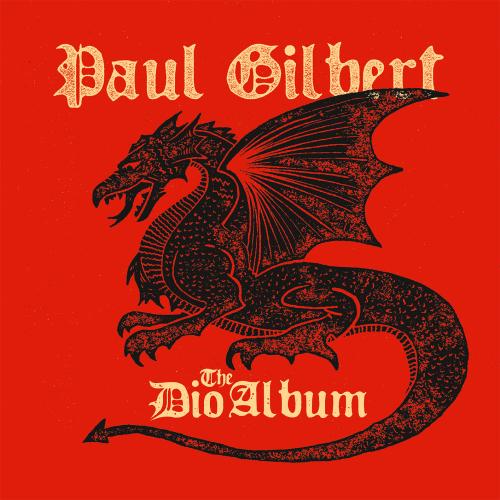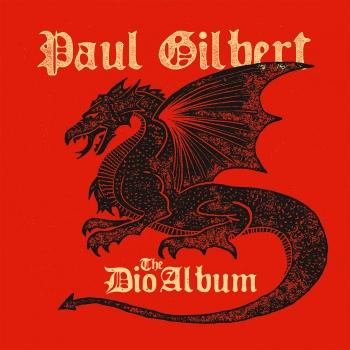
The Dio Album Paul Gilbert
Album info
Album-Release:
2023
HRA-Release:
07.04.2023
Album including Album cover
- 1 Neon Knights 04:44
- 2 Kill the King 04:51
- 3 Stand Up and Shout 03:18
- 4 Country Girl 03:59
- 5 Man On The Silver Mountain 04:19
- 6 Holy Diver 05:18
- 7 Heaven and Hell 06:26
- 8 Long Live Rock and Roll 04:26
- 9 Lady Evil 04:27
- 10 Don't Talk to Strangers 05:07
- 11 Starstruck 04:10
- 12 The Last in Line 05:58
Info for The Dio Album
It was pure chance that led Paul Gilbert to recording the music heard on latest release The Dio Album. The American guitar virtuoso, best known for his masterful fretwork in chart-topping hard rockers Mr. Big and high-octane trailblazers Racer X – as well as numerous solo records – was in his car when he saw something that made his heart start beating faster in a moment of unexpected, unadulterated joy. This was not a high value item of interest or even particularly rare, simply a baseball cap with the word ‘Dio’ emblazoned across the front. Sometimes, even for the biggest of guitar legends, it’s the little things that hit us in the most profound ways…
“I live in Portland where people love bumper stickers, right?” explains the shred pioneer. “And you get bombarded by everybody’s ideologies constantly. I look with hesitation! But I see this Dio cap on someone and I’m like ‘I could support that.’ For some reason, it hit me and I just went, ‘Yeah!’”
On his drive home, a plan was being formulated. Why not capture all of that raw energy and excitement on an album devoted to Ronnie James Dio’s most celebrated tracks – spanning across his career from Rainbow to Black Sabbath and the singer’s own solo endeavours? Of course, Mr. Gilbert is no stranger to instrumental music, but an entire album dedicated to replicating well established and world-famous vocal melodies on his trusty six-string genuinely felt like new territory. This was already shaping up to be a challenge that he would truly relish...
“When I was learning guitar, even though I wanted to rock, I also aspired to a level of perfection,” explains Paul. “Maybe I was trying to create some sort of protective shell around myself – a bit like classical or jazz musicians, who have a really refined, sophisticated technique. Their precision is astounding. They really sound like grown-ups, you know? But what I realised is that what makes vocals come alive is actually the thing that’s missing from all those perfect little notes.”
It would be fair to say human voices don’t come much more magical than Ronnie James Dio’s. He was a man who brought a sense of classical finesse to loud and heavy music, ultimately laying down the blueprint for generations and generations of rock singers to come. Taking on the daunting challenge of mimicking those distinguished vocal lines down to a tee – each legendary performance decorated with its own idiosyncrasies and nuances – actually involved unlearning some of the technical precision that turned Gilbert into a household name for guitar players in the first place…
“I’ve always loved singers,” continues Paul. “There’s some really good stuff in their type of musical expression, so why not dig into it?! A lot of harpsichord or shred guitar music isn’t quite a fluid as the human voice. I realised I wanted to really dig into what singers have to offer. I could have just gone by memory because I grew up with these songs but in order to learn something and expand my style, I decided to not to put as much of myself in this. Instead I wanted channel Ronnie. If there was something that was not in my toolbox, I wanted to get that tool – it’s all the stuff you hear in between the notes on paper.”
The Dio Album consists of 10 standout and career-defining tracks, from Neon Knights and Long Live Rock ‘N’ Roll to Holy Diver and Man On The Silver Mountain. As well as analysing Ronnie James Dio’s electrifying vocal melodies, Paul also enjoyed paying tribute to three incredibly talented guitar legends – Tony Iommi of Black Sabbath, Ritchie Blackmore of Rainbow and Vivian Campbell from the Dio band, who has been a member of British stadium rockers Def Leppard since 1992.
Each of these guitarists had their own approach to riffs and solos, all of them however managing to provide the perfect bedrock for that unmistakable voice – turning streams of consciousness into everlasting anthems that changed the world…
“Playing all these metal riffs like Stand Up And Shout, Neon Knights and Kill The King gave me serious chills,” grins Paul. “The guitar parts of Ritchie, Tony and Vivian brought no small number of goosebumps. It’s nice to be affected that way by music – it wasn’t just an intellectual ‘Oh, it’s in this key kind of thing!’ I was getting this primitive reaction to it that goes back to when we were living in trees! It made me curious like ‘Where do chills come from?’ If you see a cat and its hairs stand up, it’s because the cat’s trying to look big to fight off a predator. But luckily there were no predators in my room!”
Instead, there were fragments of his music-obsessed youth – thunderous passages that, by his own admission, made him the player he is today…
“These amazing riffs are the steel girders of the songs, upon which everything else rests,” smiles Paul. “It had been a while since I’d been this deep into metal rhythm guitar playing, and it felt like I was digging up gold nuggets of fire with a magic platinum shovel. All while wearing a star-covered wizard hat! The guitar solos in these songs came screaming from distant mountaintops. Ritchie, Tony, and Vivian set the standard breathtakingly high…
“I tried to maintain their energy and flow,” he adds. “Much of my playing was formed from learning these songs and solos as a teenager, so my instincts worked to my benefit. It felt like returning from a raging mountain blizzard to a log cabin, well-stocked with fire wood, and owned by a man who is a descendant of bears!”
Engineered by Zach Bloomstein with Paul handling all of the instrumentation, save for Bill Ray’s inspired drum work, The Dio Album is undoubtedly the most sonically accurate tribute to the songs that made Ronnie James Dio a bona fide rock and roll legend. In order to truly hone in on the late singer’s essence, Paul Gilbert dissected many of the melodies line by line, throwing every inch of himself into the music. It was the only way to capture every ounce of the energy and emotion…
“I’m hoping that some of his style rubs off on my playing, and I can have a little more of Ronnie James Dio’s spirit in my ears, hands, and heart,” concludes Paul. “Just like he sang: ‘The world is full of kings and queens who blind your eyes and steal your dreams... it’s Heaven and Hell!’ Thank you, Ronnie, and long live rock and roll.”
Paul Gilbert
Paul Gilbert
was born on November 6, 1966, in Carbondale, Illinois. When he was only 15, Gibert contacted the founder of Shrapnel Records, Mike Varney, looking for a job playing with Ozzy Osbourne. Gilbert didn't get his job playing with Osbourne, but Mike Varney was so impressed with the boy's playing that he kept in communication with him. When Gilbert was 16, Varney featured him in his Spotlight Column in the February issue of Guitar Player magazine. After graduating high school, Gilbert moved to Los Angeles to attend the Guitar Institute of Technology. Gilbert was such an advanced student that he was hired on as an instructor when he graduated.
While he was attending the Guitar Institute of Technology, Paul met John Alderete, another student at the school. The two enlisted the help of drummer Harry Gschoesser and singer Jeff Martin, who had been playing in the metal band Surgical Steel. Since Surgical Steel was based in Phoenix, he couldn't be at writing sessions. Gilbert recorded demos and sent them to Jeff to write lyrics for. The band, going by the name Racer-X, began recording their first album, "Street Lethal". Mike Varney released the album on his Shrapnel label.
"Street Lethal" immediately gained Paul Gilbert the reputation as a member of the new style of guitar playing known as neo-classical, popularized by Yngwie Malmsteen and Randy Rhodes. The track, "Y.R.O." on the album acknowledges Malmsteen's influence on Gilbert; Y.R.O. stands for Yngwie Rip Off. The success of the album lead to Gilbert receiving an endorsement deal with Ibanez guitars.
The band took on a second guitarist for their next album. Gilbert, who was still teaching at the Guitar Institute of Technology, was particularly impressed with the skills of one of his students, Bruce Bouillet, and invited him to join Racer-X. The two guitarists redefined Racer-X's sound, borrowing the twin lead guitar concept from bands like Judas Priest and merging it with the neo-classical and shred guitar sound of the band. Racer-X was almost left without a drummer for the second album when Harry Gschoesser's visa expired and he had to return home to Austria. He was replaced by Scott Travis, who was the first choice for drummer when the band was formed. Travis couldn't join the band then because he had a steady gig with a band in Virginia. The second album, "Second Heat", was released in February 1988.
By that time, the band was reaching the height of it's popularity, they were selling out shows and getting a steady stream of bookings. They recorded two live albums of back to back performances at the Country Club, "Live Extreme, Volume 1", and "Live Extreme, Volume 2". The band was growing increasingly dissatisfied with not being able to secure major label distribution, and when Billy Sheehan left David Lee Roth's group and invited Gilbert to join his new project, Gilbert accepted.
Sheehan's new band, with Gilbert on lead guitar, was dubbed Mr. Big. The band's self titled debut had a major label release under Atlantic records in 1989. The album was a big seller in Japan, but failed to bring them major sales in the United States. Their breakthrough stateside came with the release of their second album, "Lean Into It". The album's single "To Be with You" was number one in 15 countries. The bands next two albums were not as successful in the U.S., but the band's fame continued to rise in Japan.
In 1997, Gilbert left Mr. Big and recorded a solo album under Mr. Big's Japanese label. A year later, Gilbert got the idea to relaunch Racer-X with the help of his new Japanese label. The label agreed, as did all of the members of Racer-X, except Bruce Bouillet. The resulting album, "Technical Difficulties", went gold in Japan. The label wanted another album, and Racer-X obliged with the recording of "Superheroes", which became one of their most popular albums.
Gilbert worked on a solo album in 2002, releasing "Burning Organ", but the label wanted another Racer-X album. The band got together at Gilbert's house in Las Vegas to record the album. The result, released later that year, was "Getting Heavier". After the album, the band disbanded for good. Paul Gilbert continued work on his solo career and the other members all found work with other bands.
Paul did reunite briefly with his Racer-X band-mates in 2009 to play the NAMM show in Anaheim, California. (metalstorm.net)
This album contains no booklet.










